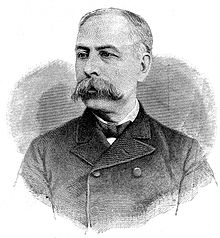Augustus O. Bourn
| Augustus Osborn Bourn | |
|---|---|
 |
|
| 36th Governor of Rhode Island | |
|
In office May 29, 1883 – May 26, 1885 |
|
| Lieutenant Governor | Oscar Rathbun |
| Preceded by | Alfred H. Littlefield |
| Succeeded by | George P. Wetmore |
| Member of the Rhode Island House of Representatives | |
|
In office 1876–1883 1886–1888 |
|
| Personal details | |
| Born |
October 1, 1834 Providence, Rhode Island |
| Died | January 29, 1925 (aged 90) |
| Resting place | Swan Point Cemetery |
| Political party | Republican |
| Spouse(s) | Elizabeth R. Morrill |
| Alma mater | Brown University |
| Profession | Businessman |
Augustus Osborn Bourn (October 1, 1834 – January 29, 1925) was an American politician and the 36th Governor of Rhode Island.
Bourn was born in Providence, Rhode Island, on October 1, 1834. He was the son of George O. Bourn and Huldah B. (Eddy) Bourn and married Elizabeth R. Morrill February 24, 1863. He and his wife had five children. He graduated from Brown University and later established a successful career in rubber business, where he started in his father's company. He continued the business after his father's death and incorporated it as the Providence Rubber Company. He also founded the National Rubber Company, which later merged with the former company.
During the Civil War, Bourne enlisted in the Rhode Island Militia but did not see active service with the Union Army. On April 18, 1864 he was elected as paymaster, with rank of 2nd lieutenant, in the Providence Horse Guards (PHG). On April 17, 1865 he was commissioned a first lieutenant in Company A of the PHG. On April 20, 1868 he was elected as captain of Company A and two years later he became captain of Company B. In 1871 he returned his previous position as captain of Company A.
On April 20, 1874 he was commissioned as major of the PHG. On May 13, 1878 he was commissioned as lieutenant colonel in command of the 1st Squadron of Cavalry. He held that position until he took office as Governor of Rhode Island in 1883.
Bourn was a Republican and was member of the Rhode Island State Senate in 1876–83 and again in 1886–88. He held the governor's office from May 29, 1883 to May 26, 1885. During his administration, a constitutional amendment was proposed to extend suffrage to naturalized citizens. He was the author of this amendment. Later this constitutional amendment became well known as the Bourn Amendment.
Bourn was an active member of the Freemasons.
In 1873, Bourn built an opulent Gothic revival mansion in Bristol named Seven Oaks. The mansion was designed by James Renwick, best known for designing the Smithsonian Castle and St. Patrick's Cathedral, and is located at 136 Hope Street near the Herreshoff boat yard.
...
Wikipedia
